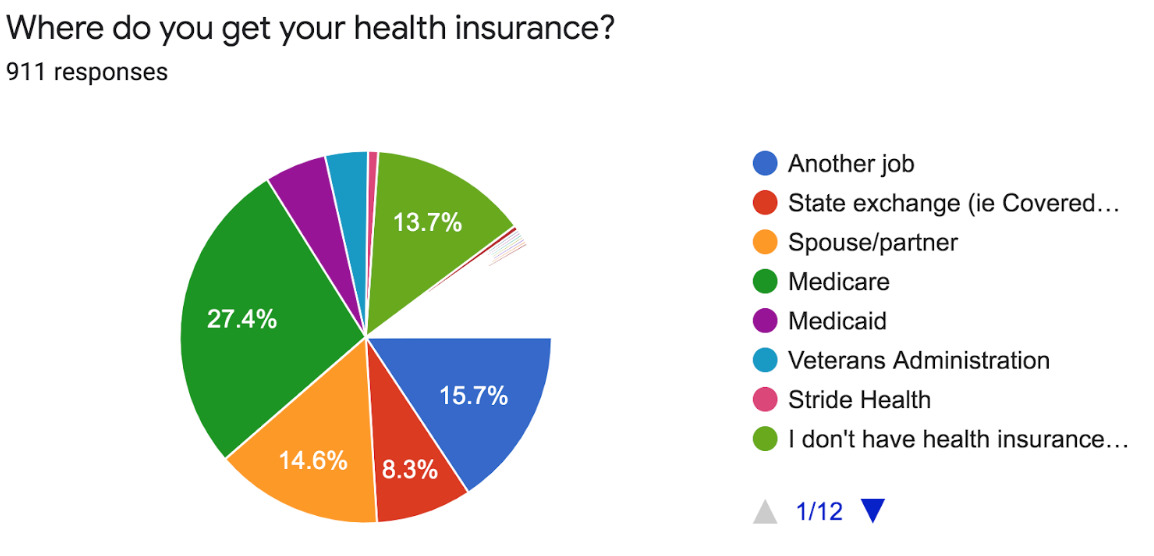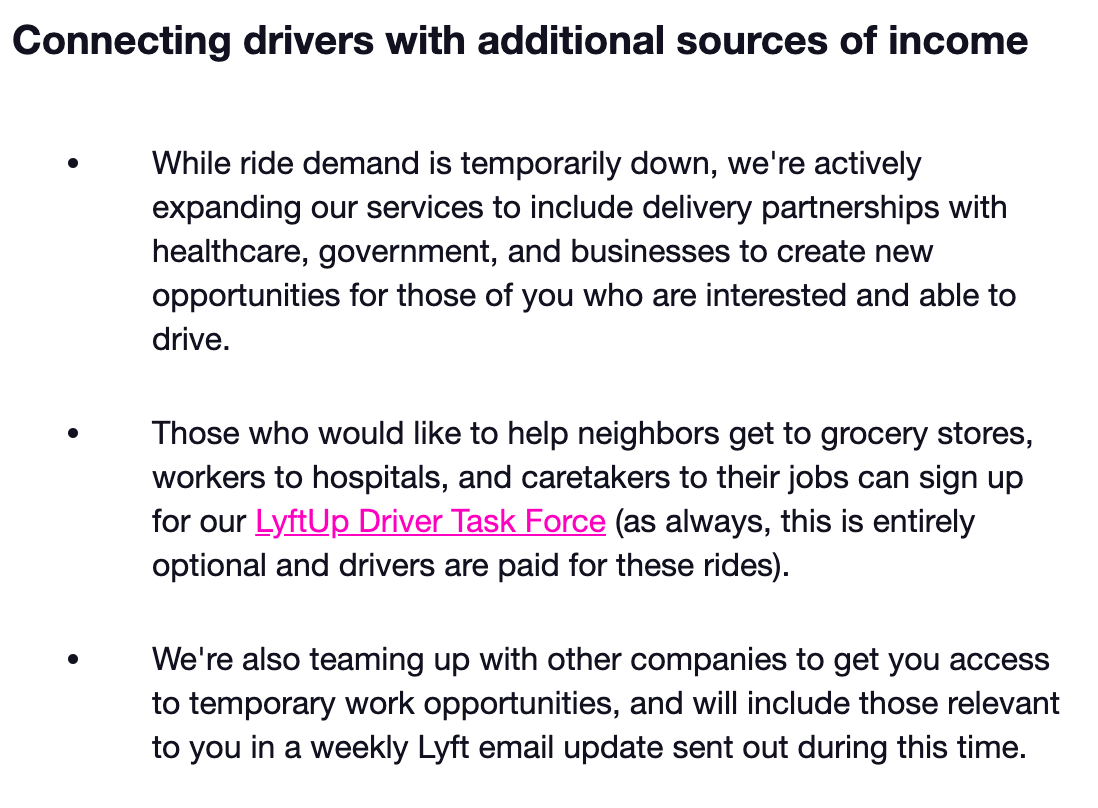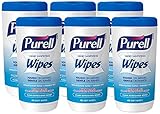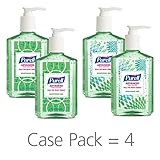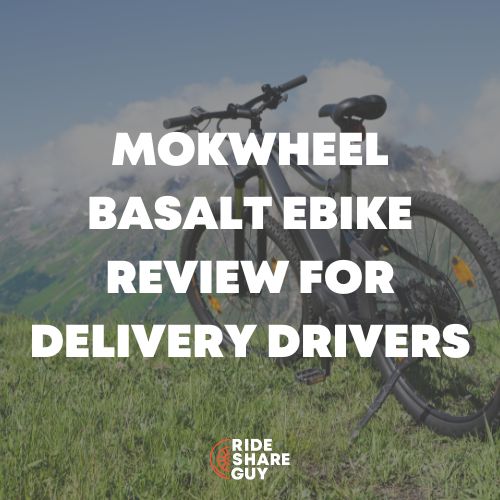Ever since the coronavirus broke out, drivers and many other independent contractors have been stuck in limbo. Do they continue driving and delivering to earn money? What if they can’t, for various reasons, continue to work?
The US federal government stepped in with March’s Coronavirus Aid, Relief and Economic Security (CARES) Act. Below, we’ll explain these programs, break down their acronyms, and explain how they help drivers and other independent contractors.
Coronavirus Small Business Assistance Programs
CARES Act
The Coronavirus Aid, Relief, and Economic Security (CARES) act is a law meant to address the economic fallout of COVID-19 in the United States.
Paycheck Protection Program and Health Care Enhancement Act (PPPHCEA)
This bill, passed in April, adds funds to banks to make new PPP loans after borrowers exhausted the initial allocation of $349 billion within the program’s first few days.
Unemployment Insurance (UI)
Unemployment insurance or unemployment benefits is a type of state-provided insurance that pays out when you lose your job and meet certain eligibility requirements.
Pandemic Unemployment Assistance (PUA)
A program that temporarily expands unemployment insurance eligibility to self-employed workers, freelancers, independent contractors and part-time workers impacted by the coronavirus pandemic.
Federal Pandemic Unemployment Compensation (FPUC)
As long as an individual is eligible for some type of unemployment (including PUA), s/he will also be eligible for an additional $600 per week for the weeks of March 29 – July 31.
Pandemic Emergency Unemployment Compensation (PEUC)
This is the provision that allows unemployed individuals to get 13 additional weeks of unemployment benefits after they exhaust their state unemployment benefits.
Small Business Administration (SBA)
The SBA is a US government agency that provides support to entrepreneurs and small businesses.
Economic Injury Disaster Loan (EIDL) Program
Can provide up to $2 million of financial assistance to small businesses or private, non-profit organizations that suffer substantial economic injury as a result of the declared disaster, whether or not the application sustained physical damage.
EIDL Advance
This part of the EIDL program provides up to $10,000 in emergency relief that does not have to be repaid, making it effectively a grant. To receive it, you must apply for EIDL. Whether your EIDL is approved or not, the advance does not have to be repaid and you should receive it within days following a successful EIDL application.
Paycheck Protection Program (PPP)
A new loan program that provides loans on behalf of the SBA to small businesses affected by COVID-19. PPP loans are eligible for forgiveness, which means the lender can release the borrower from the obligation to repay the balance. The amount forgiven is determined by the amount the borrower spends during the 8 week period on payroll costs, interest, rent, and utility with no more than 25% of the loan amount spent on non-payroll costs.
Employment Development Department (EDD)
Offers a wide variety of services to millions of Californians under unemployment insurance and now also PUA. Every state has some sort of employment department, but they may have different names or acronyms.
Coronavirus Driver Survey
With all of the recent coronavirus news, we wanted to know: how have drivers been affected nationwide and what are drivers doing differently to combat the spread of the coronavirus?
So, we sent out a survey to our email list of 60,000 drivers and followers on social media and collected nearly 200 responses from 3/13/20-3/16/20. You can view our full, annual Uber driver survey here.
For all media requests, please e-mail harry@therideshareguy.com and if you cite any of the figures below, all we’d ask is that you link back to our post on TheRideshareGuy.com.
Demand and Earnings Are Way Down
We have been hearing from a number of drivers about lower demand but this survey confirmed that drivers are seeing way less demand than usual and earnings are also down.
81% of Uber and Lyft drivers say that they have seen a decrease in demand. And 80% of drivers say that their earnings are also down.
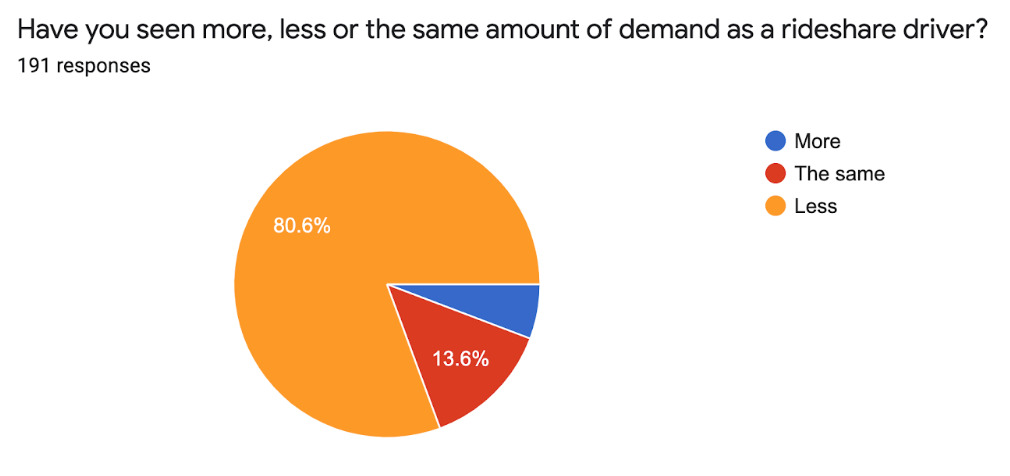 One interesting trend we noticed was that over the course of 4 days, demand continued to decrease with each passing day.
One interesting trend we noticed was that over the course of 4 days, demand continued to decrease with each passing day.
On Friday 3/13, 75% of drivers indicated that they were seeing decreased demand and on Monday 3/16, that figure jumped to 82.9%. As more restaurants, bars and similar venues close, we expect this trend to continue.
 Drivers Are Also Driving Less
Drivers Are Also Driving Less
Drivers are at high risk for transmission since they are transporting multiple people a day and sitting in a confined space for hours at a time. This has led 24% of drivers to stop driving completely and 39% of drivers say that they’re driving less because of the coronavirus.
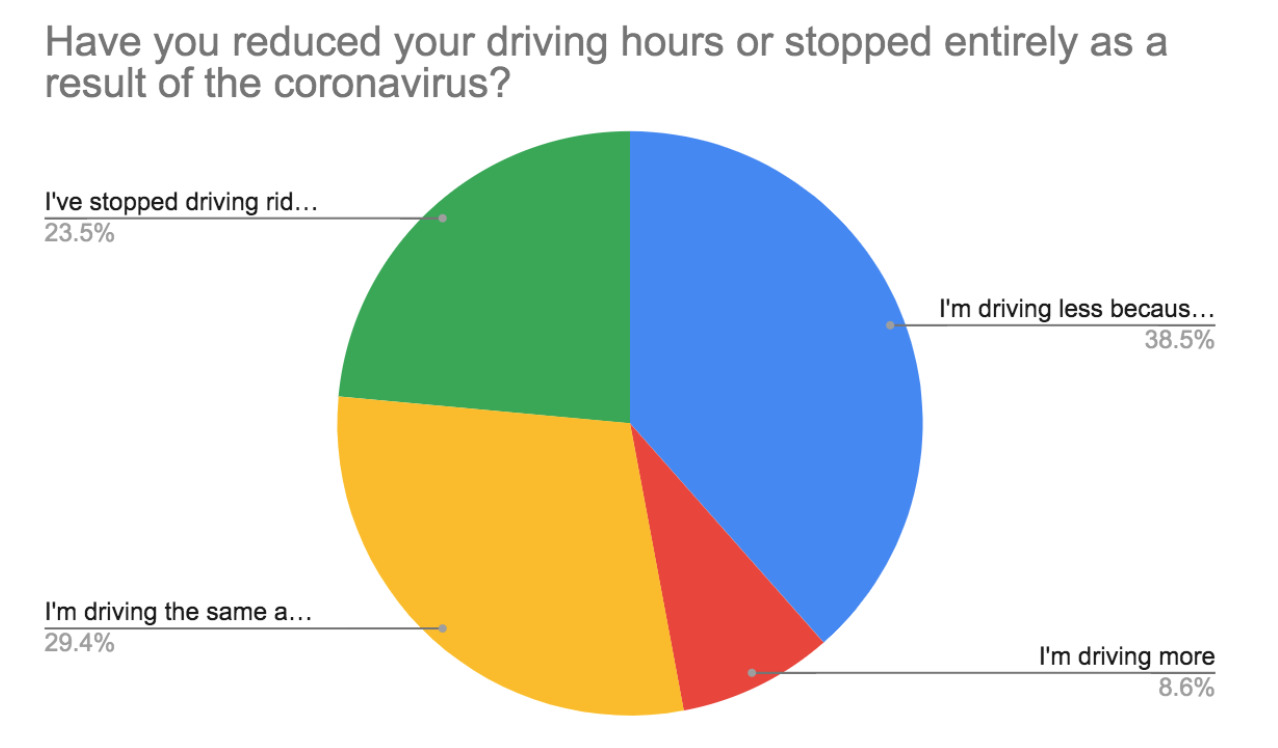 Many of the reasons given by these drivers for driving less are the social distancing effect or the fact that some of them have their own health-related issues that make it more harmful to interact with dozens of strangers every day.
Many of the reasons given by these drivers for driving less are the social distancing effect or the fact that some of them have their own health-related issues that make it more harmful to interact with dozens of strangers every day.
Fortunately, 35% of drivers do have access to other income or work, which could be another reason why those drivers, in particular, have stopped driving or are driving less. But a majority are faced with a tough choice: drive and potentially transmit/get exposed to coronavirus or stop driving and lose out on their income.
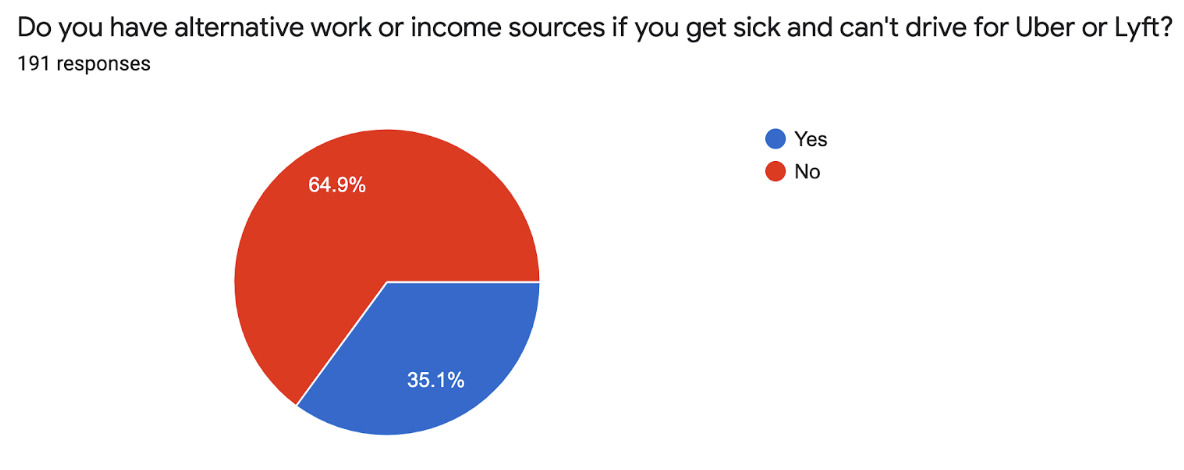
Another concern for drivers is the lack of health insurance. According to our annual Lyft and Uber driver survey, we found that 76% of drivers have some type of health insurance, but 13.7% don’t have health insurance. So while a vast majority have access to some type of health care, there are nearly 14% who don’t have health insurance at all, putting another strain during a time of lost income and pandemic.
As this driver shared,
“Sickness is not an option for me because not working is not an option. If I do get sick, I will have to continue to work or I will lose my ability to exist – it’s not just income. Before the coronavirus outbreak, I managed to pay my bills on a monthly basis, with no room for error. Here are the things at risk: paying rent, my car payment, my health insurance, and of course food. If I have to stop working without any safety net I would lose all of these things.” – Edan A., driver and organizer with Gig Workers Rising
How Are Drivers Dealing With This?
Uber and Lyft were slow to respond to the coronavirus outbreak, so many drivers have taken it upon themselves to stay safe. One driver shared their cleaning/disinfectant strategy, which riders appreciate:
“I posted 3 signs for passengers to notify them that I am using disinfectant before and after all passengers to clean any surfaces that previous passengers may have touched. I also inform passengers that there are containers of disinfectant wipes under the front and rear of the front passenger seat if they would like to wipe anything or they can take a wipe with them for future use. Many positive comments from passengers.”
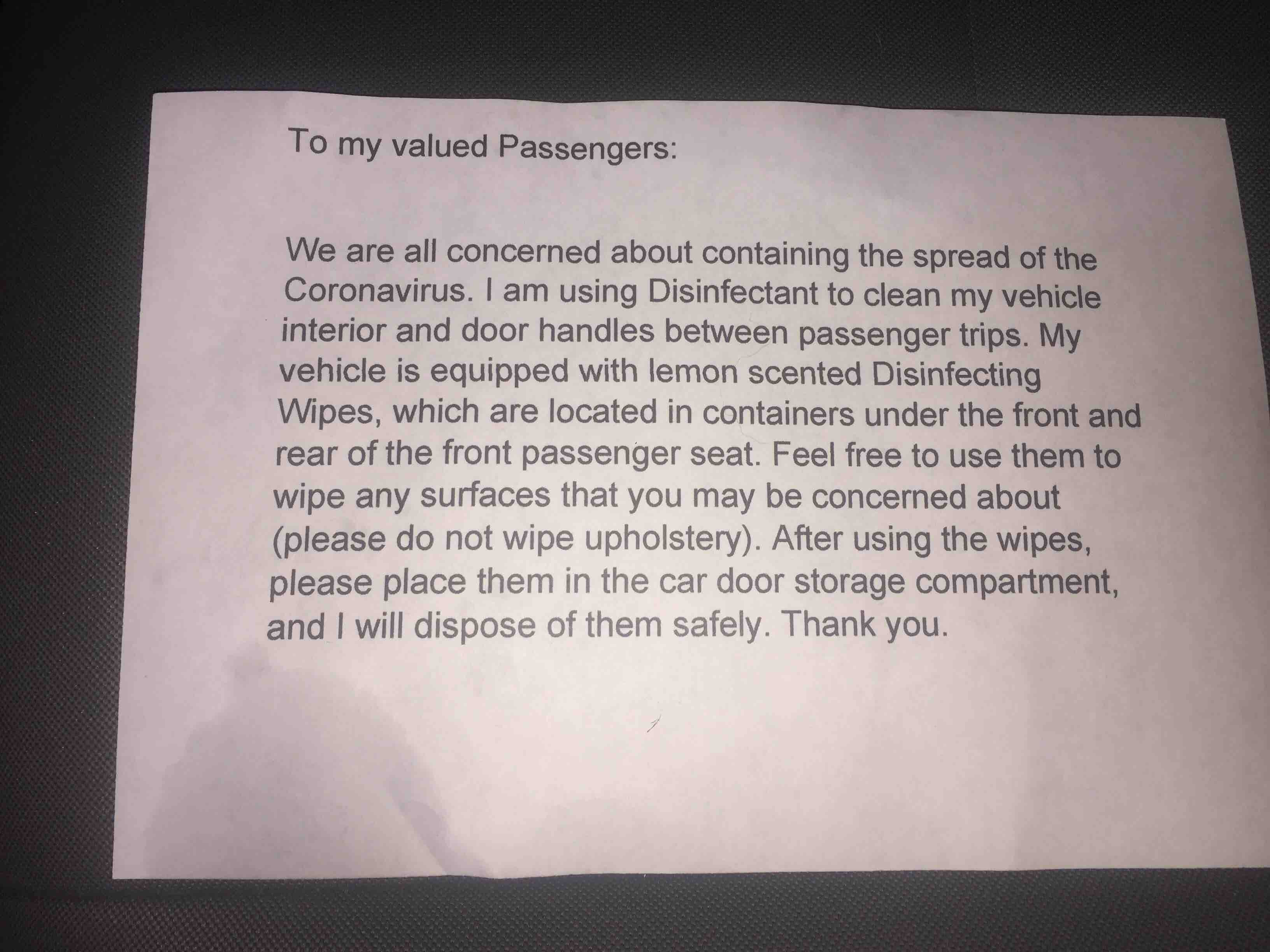
Others shared tips on ventilation and how they handle trips to the airport:
“I keep constantly ventilation in my car opening a little the front window, I always spray Lysol 99.9% germ killer after finishing a trip when the rider is outside from my car; sanitized with gel my hands constantly, specifically if I have to touch luggage at the airport, which I’m trying to avoid more at this special time. Thank God I’m in great health condition.”
Passengers can rest assured, at least from our survey respondents, that drivers are doing just as much as you would want them to during a pandemic. After all, drivers also have to be in the car with passengers, and in most cases, that driver’s car is their day-to-day vehicle – they want to keep it clean for themselves too!
Uber and Lyft are Not Doing Enough
Drivers are less than pleased with Uber and Lyft’s response so far to the coronavirus outbreak. 78% of drivers do not believe Uber and Lyft are doing enough to support drivers.
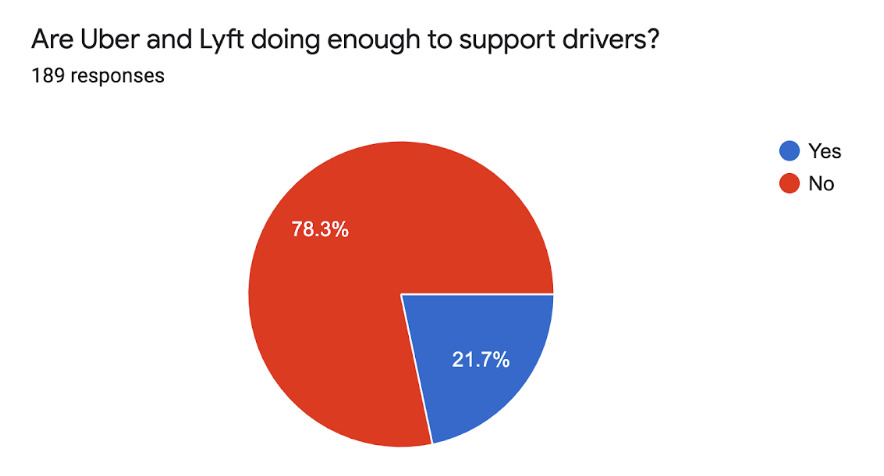 Uber has announced that drivers will receive financial assistance if they are diagnosed with COVID-19 or placed in individual quarantine by a public health authority (and Lyft is working on a similar plan). But drivers definitely want more:
Uber has announced that drivers will receive financial assistance if they are diagnosed with COVID-19 or placed in individual quarantine by a public health authority (and Lyft is working on a similar plan). But drivers definitely want more:
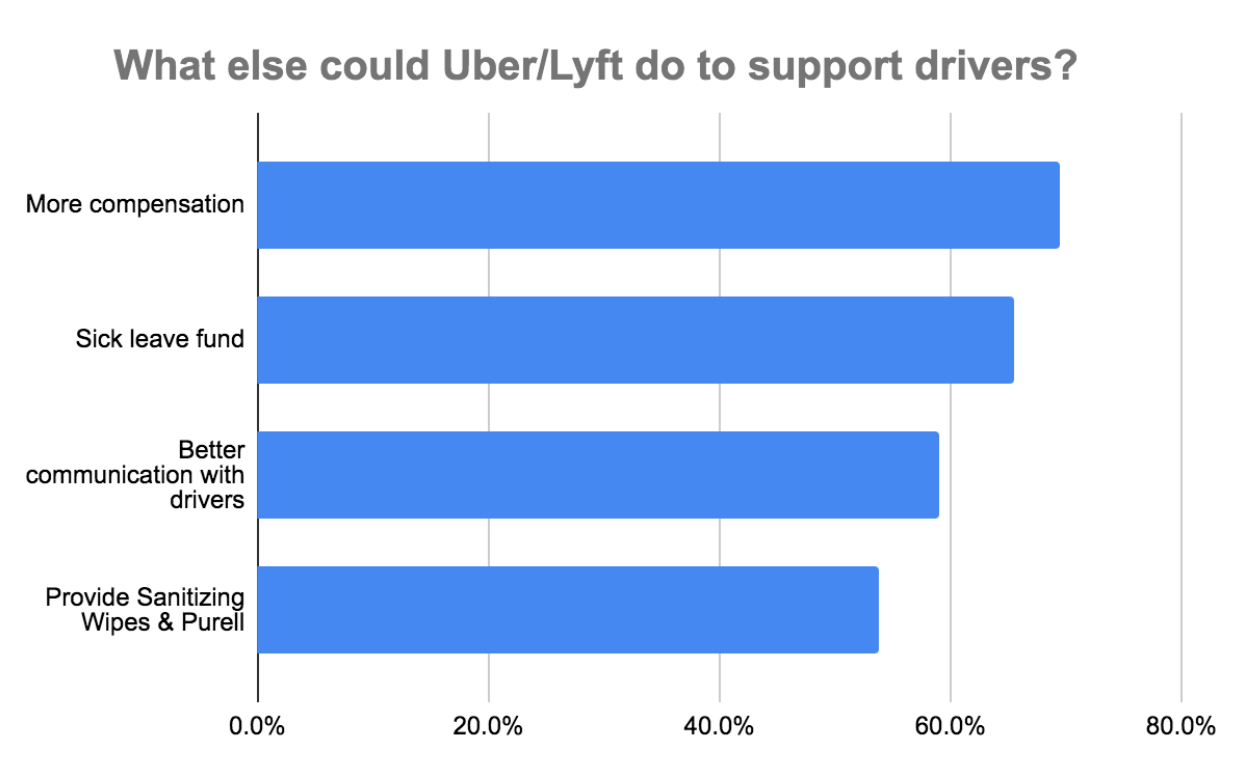 More compensation was requested by 69% of drivers and there were a number of comments that echoed this statement from a driver, “Since Uber and Lyft classify us as independent contractors, we don’t have any recourse when business slows down to utilize sick days or workman’s compensation, especially in this pandemic.”
More compensation was requested by 69% of drivers and there were a number of comments that echoed this statement from a driver, “Since Uber and Lyft classify us as independent contractors, we don’t have any recourse when business slows down to utilize sick days or workman’s compensation, especially in this pandemic.”
More than one respondent mentioned how their cities, in particular, rely on tourism, and how this pandemic has not only decimated the tourist industry, but also almost all demand for drivers. One driver summed up their despair with this comment left on our survey: “We need sick pay! How am I to pay my bills?”
59% of drivers merely want better communication – even just to acknowledge what they are doing. According to one respondent:
“Sending an email to Uber and Lyft riders reminding them that their drivers are risking their health in order to provide them a ride. Maybe even an acknowledgment from Uber and Lyft to thank the drivers for continuing to drive which enables Uber and Lyft to run normally and for riders to get where they need to go. I think this would help both Uber and the driver. The driver would probably receive more tips and Uber can represent itself as a company still providing services.”
Luckily, drivers are not alone in their fight for safer working conditions and compensation. In addition to Gig Workers Rising, the Independent Drivers Guild is also taking steps to help drivers:
It is really tough out there and it likely to get even tougher in the days ahead, but drivers’ voices are making a difference. Together we have pushed Uber and Lyft to expand sick pay for drivers and to stop pooled rides that put us all at greater risk. Uber has now agreed to provide sick pay to drivers who have a doctor’s note directing them to self-isolate and Lyft tells us they will provide compensation based on a doctor’s note as well. If you are a driver and you are sick or at high risk of infection due to age or pre-existing conditions like diabetes or lung disease, please consider calling your doctor and applying for sick pay.” — Moira Muntz, Independent Drivers Guild spokesperson
Recently, Uber, Lyft and other gig economy companies have offered more information for how they plan to help drivers. Read the full list of how Uber and Lyft are helping drivers during the coronavirus here, but below is a quick summary:
- Uber – Drivers must be diagnosed to receive ‘financial assistance’. What that looks like, how much, and when drivers will receive it is still up in the air.
- Lyft – If you provide documentation that you have COVID-19, you will receive funds ‘based on your performance on their platform over the previous four weeks.’
- Instacart – Offering sick pay (regardless of the virus) and 14-day sick leave for those diagnosed with COVID-19.
- DoorDash – Drivers can receive two weeks of financial assistance if they are diagnosed with COVID-19.
- Postmates – Offering 14-day sick leave pay and the Postmates Fleet Relief Fund, which will help to cover costs associated with medical expenses related to COVID-19, regardless of diagnosis. Go Postmates!
Read more about all of the options for drivers affected by the coronavirus and learn how to submit your documentation.
Some drivers are pursuing compensation from Uber right now. You can read the full story of how Uber is compensating drivers who have the coronavirus, but here are some important takeaways from that article:
- A doctor must provide you a note saying you are quarantined
- You will have to sign some terms and conditions
- The drivers we’ve spoken to are getting paid by Uber – which is good!
Update: March 20, 2020: Lyft has announced expanding services to include delivery partnerships with healthcare, government and business to create new opportunities for drivers. In addition, drivers can sign up for the LyftUp Driver Task Force, which pays drivers to help neighbors get to grocery stores, workers to hospitals, and more.
According to RSG contributor Paula,
“We’ve heard a lot of “talk” from Lyft and Uber over the past couple of weeks when it comes to what they are doing for drivers in this time of the coronavirus (COVID-19). And in certain markets, it seems like it is just talk. It could be that Minneapolis/St. Paul doesn’t have “enough” cases of people testing positive for them to bother with us at the moment.
We haven’t received any further information about the free hand sanitizer both Lyft and Uber have promised to “affected communities” or any other “perk” they’ve offered during this time.”
You can sign up for the Task Force at that link and tell them how you feel they could best serve you. It’s unknown what they will do with this information. Obviously, they won’t be able to accommodate every driver’s request, but it at least shows they are willing to listen. They also ask what you are willing to do to help, such as giving rides to foodbank volunteers and essential grocery store staff, etc.
In addition, Lyft links to information about tax credits, help for drivers who own their own businesses, but it’s hard to tell if the tax credit they reference is available to drivers who are choosing to self-isolate in order to stop the spread of COVID-19 or are self-isolating because they are afraid of catching the disease.
Update April 2020: Lyft has put together an FAQ designed to help drivers seeking unemployment and more information about how the CARES Act impacts them here.
Update May 2020: How do drivers feel about becoming employees vs. remaining independent contractors? Our latest news on the California lawsuit and our driver W2 vs. IC survey results here.
Uber and Lyft appear to have heard drivers – they recently announced new safety features for both drivers and passengers. Read more about the new features here: Uber and Lyft Announce New Safety Requirements For Drivers.
HopSkipDrive, a rideshare app transporting kids, also announced they will include plastic dividers between the front and back seats for their drivers and passengers plus provide sanitizing kit with PPE.
The Coronavirus Aid, Relief, and Economic Security (CARES) Act Includes Unemployment for Rideshare Drivers
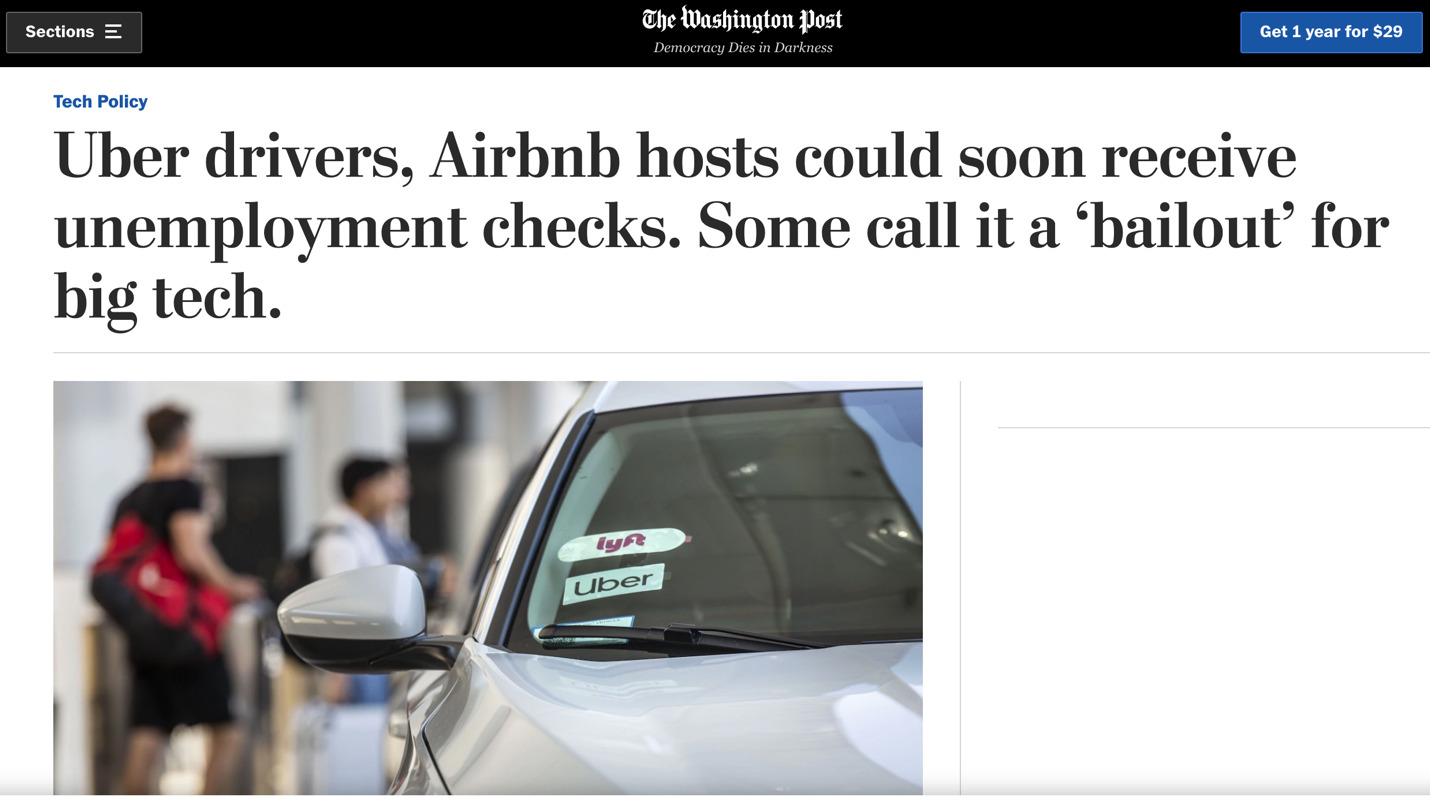
On Friday, March 27, 2020, the $2.2 trillion stimulus bill (called Coronavirus Aid, Relief, and Economic Security (CARES) Act) went into law. The package includes unemployment insurance for independent contractors. In addition, every single American making $75,000 or under will receive a check for $1,2000 (double both the income thresholds and the amount if you’re married).
How are Uber and Lyft helping drivers navigate all of this? Uber has created an Independent Worker’s Guide to COVID-19, which will help you with the latest COVID-19 information, how to get financial support if you’re quarantined because of COVID-19 and more.
As far as Lyft, they’re keeping drivers updated on all the latest via email, app alerts, and their COVID-19 Safety website here.
Specifically, on their “What the CARES Act Means for You” page, Lyft provides additional information for ICs:
“Other drivers who are self-employed, including independent contractors, may be eligible to receive compensation through a new temporary Pandemic Unemployment Assistance program now through December 31, 2020. Those who are unable or unavailable to work as a direct result of the coronavirus public health emergency qualify for this assistance.
The program offers up to 39 weeks of benefits – with weekly benefits of at least half the average weekly benefit under regular unemployment insurance plus an additional $600 per week for up to four months.”
And finally, while Lyft Hubs may be closed right now, Lyft states they are working on distributing hand sanitizer and cleaning wipes to drivers at no charge. You’ll be alerted via your app when they are ready for pick up in your area.
Understand that right now, the situation is changing rapidly and Uber and Lyft are working on getting more specific information out to drivers as it becomes available.
Offering assistance to independent contractors is unprecedented, so while Uber and Lyft work to get drivers more info, the best thing you can do is: apply for unemployment insurance through your state unemployment agency.
Here is how you can apply for Pandemic Unemployment Assistance (PUA):
In California, $450 per week is the maximum standard unemployment benefit, while New Jersey provides up to $713 per week.
The stimulus package then includes up to an additional $600 per week (for four months). Depending on your earnings over the past year, a Californian could collect up to $1,050 per week for up to four months.
The bill also extends standard unemployment for an additional 13 weeks, which for most states will equate to a total of 39 weeks of coverage.
In addition, you may be able to apply for an Economic Injury Disaster Loan grant of up to $10,000. Take a look at the instructional video below, and then click here to learn about applying for the Economic Injury Disaster Loan program.
Switching to Food Delivery
23% of respondents were already driving for a delivery service and 29% more indicated that they are thinking about switching to delivery.
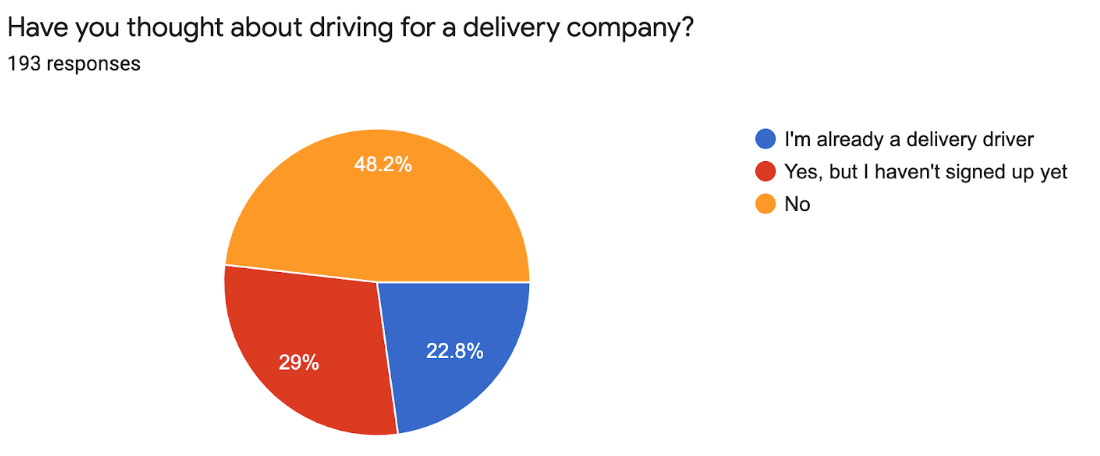 For those currently doing delivery, Uber Eats was the most popular option at 47% while DoorDash came in second at 40 and Postmates rounded out the top 3 at 37%.
For those currently doing delivery, Uber Eats was the most popular option at 47% while DoorDash came in second at 40 and Postmates rounded out the top 3 at 37%.
One of our best recommendations for drivers who are worried about coronavirus is to consider signing up for a food delivery service as there’s much less exposure potential and the income is comparable.
Drivers are not reporting a large spike in food delivery orders yet, but that could be coming now that more cities and states are moving to close restaurants and bars and only allow for to-go or delivery orders.
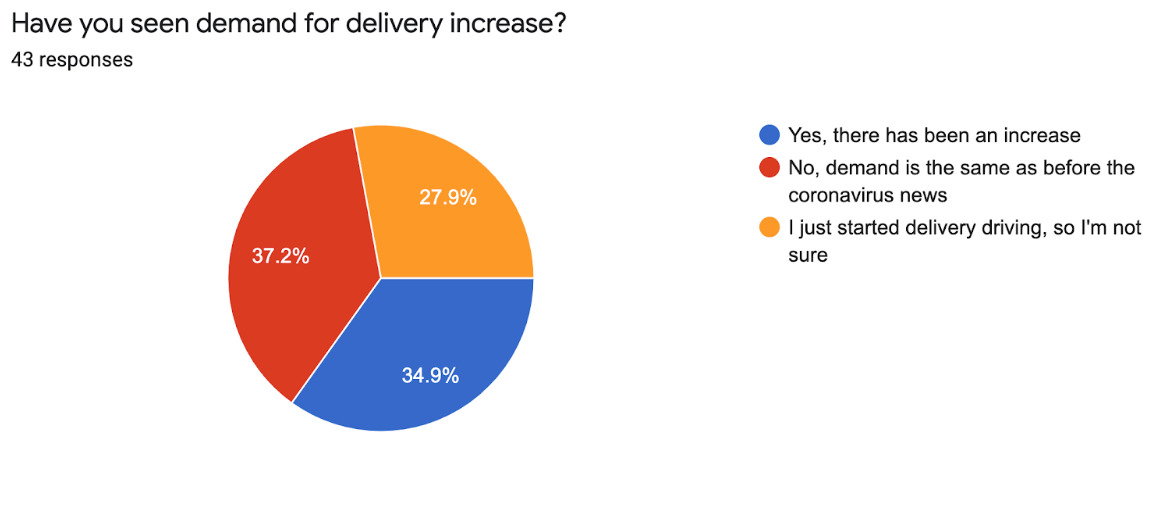 Accordingly, delivery income was not hit as hard as rideshare income. 75% of delivery drivers say that they’re earning the same or more than they were before the coronavirus outbreak. 25% of drivers actually report making more money.
Accordingly, delivery income was not hit as hard as rideshare income. 75% of delivery drivers say that they’re earning the same or more than they were before the coronavirus outbreak. 25% of drivers actually report making more money.
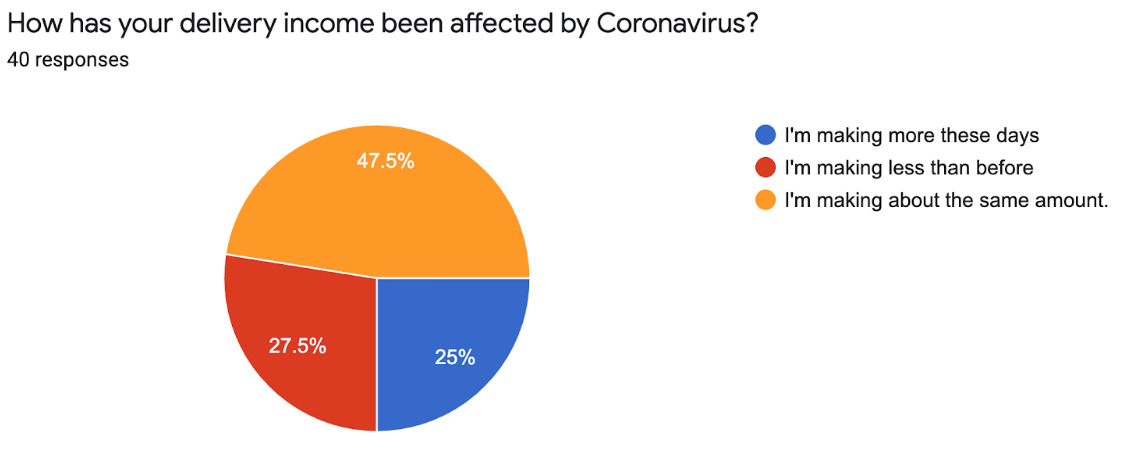
Work Opportunities for Uber and Lyft Drivers
Now you have a choice to make. Do you want to work, or do you want to collect unemployment?
If you are working, you can’t claim unemployment. If you live in California, is $10K over 2 months enough to keep you going? Do you need money now and can’t wait three to four weeks for funds to flow into your bank account?
If you can’t wait, we recently updated our best delivery jobs for Uber drivers article, where we covered some of our favorite delivery companies like:
- Uber Eats – easiest to get started with right away
- DoorDash – typically has some of the highest payouts for couriers
- Postmates – similar to DoorDash – sign up for both until you see which one is more profitable in your city
- Instacart – extremely busy right now, and is forgiving any less than 5-star ratings from customers
In addition to these gig jobs, we’ve also found a few more that may be hiring in your city, including:
- NYC’s Taxi & Limousine Commission is hiring Uber and Lyft drives for meal delivery. Learn more here.
- Roadie – sign up to become a parcel driver with Roadie
- Field Nation – online jobs for technicians (mainly IT)
- Rynly – delivery packages with Rynly (only available in Portland and Seattle right now)
- Saucey – deliver alcohol with Saucey
- Drizly – clearly, people need to drink. Deliver alcohol from your local liquor stores with Drizly.
Read more about how to handle the coronavirus impact on your finances and health here and learn how to make 100 dollars fast here.
7 Ways Uber and Lyft Drivers Can Survive The Coronavirus
We asked senior RSG contributor Jay Cradeur how rideshare drivers can prepare themselves for the coronavirus economic-impact fall out…
There is an old adage, “better safe than sorry,” which rings very true for me. As much as I’d like to go out and see what driving is like right now, I’d prefer to avoid having 20-30 strangers in my car over the course of a day.
In this article, I will share with you seven ways rideshare drivers can survive the coronavirus’ impact on their finances and keep themselves safe during this pandemic.
Quick tips:
- Stay up to date on the latest rideshare news by bookmarking this article!
- Don’t drive if you can avoid it!
- Sue the rideshare companies
- Avoid the airports
- Drive for delivery
- Make sure to keep hand sanitizer in your car
- Take advantage of sick leave policies
1) If You Don’t Have To Drive, Then Don’t Drive
Instead, take a road trip and go someplace where you can enjoy nature and avoid people.
Fortunately, I have taken my own advice over the past several years and have developed a solid Plan B. I have articles to write, videos to make, and a few other activities to keep me busy.
If you have been creating a Plan B, now is a good time to fully engage. There is no doubt that anyone you come into contact with in your car could be a carrier of the virus.
If you can avoid driving to protect your health while this pandemic is in full force, then don’t drive.
2) If You Have To Drive And You Are Angry About It, Sue The Rideshare Companies
If drivers were actual employees of Uber or Lyft right now, we would be entitled to paid sick leave, unemployment benefits, etc. Many of the issues drivers are facing right now in relation to the coronavirus would likely be solved by having drivers be actual employees, instead of independent contractors.
We’re not saying being an employee is the way to go for everyone, but at a time when we’re having to discuss being financially sound in the threat of a crisis that may leave many earning much less than before, this is a time when being an employee would really pay off.
If you have had enough of the pejorative policies the rideshare companies have been tossing our way, you can take action.
I have and it feels pretty good. According to Mark Potter at Potter Handy LLP, drivers have rights:
“Gig driver companies (Uber, Lyft, Doordash, etc) know they are illegally paying their less than ½ of what is required under California law. Their arbitration clauses have thus far been able to keep cases and settlements confidential. I want to get the word out that I will do the hard work that is required to individually arbitrate each and every of my clients’ claims to get them full recovery. My average client is entitled to well over $100,000 under California law so it is well worth them pursuing their claims.”
If you are a California driver and want to see what you are entitled to, click here to access the Potter Handy Damage Calculator. It is the first step to securing representation, all at no cost to you, the driver.
Not Everyone Can Stop Driving
I get it. When I first started driving, I had to drive. It was my sole source of revenue and with a long list of financial commitments, I had very little choice.
Given that according to our most recent survey, 70% of you also rely on Uber/Lyft as your sole source of income, let’s look at some practical actions you can take to maintain your health and keep you on the road.
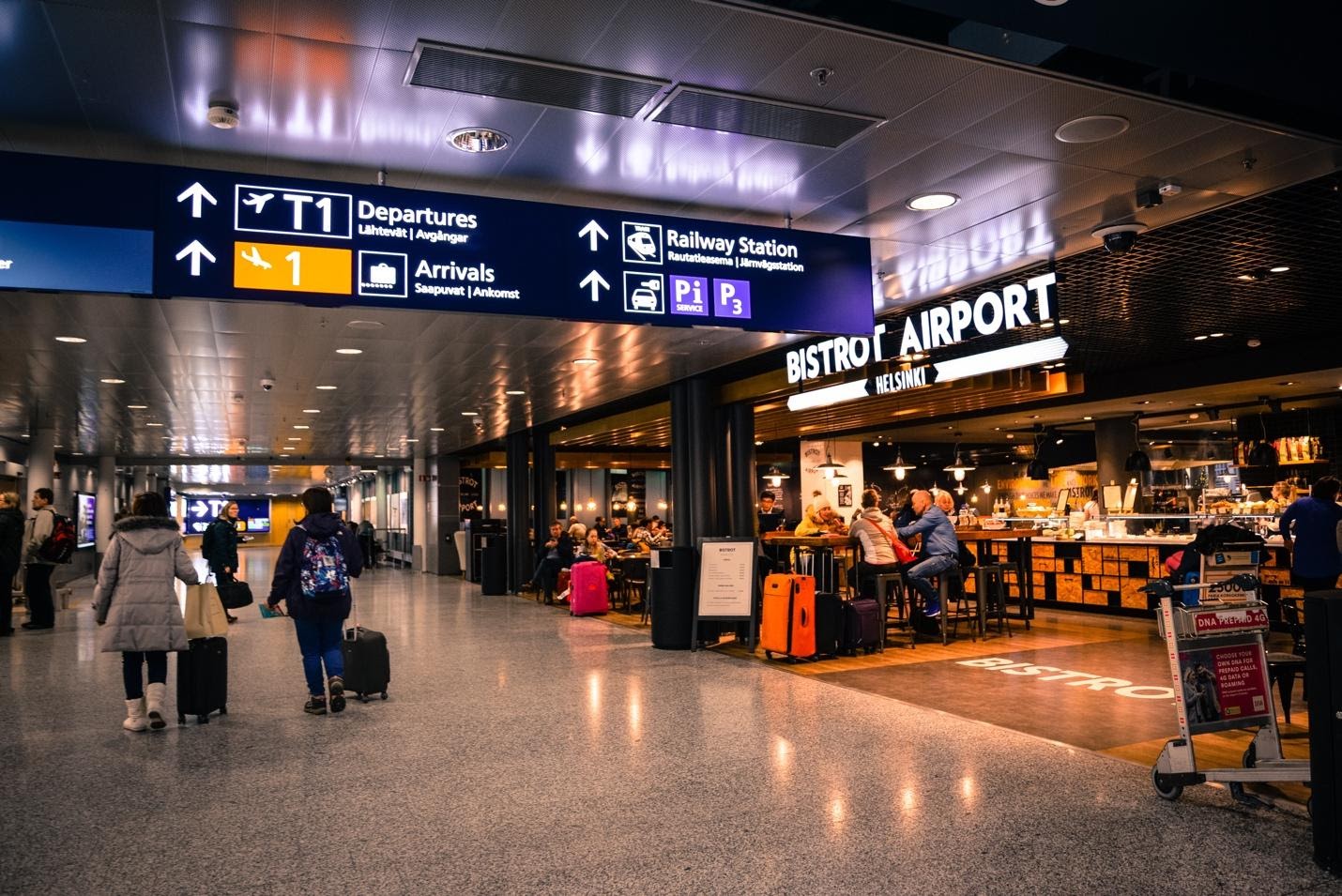
3) Avoid Airports
If you have followed my articles over the years, you know that I never wait at the airport for a pickup.
In my home market, I can drive 12 minutes from the airport and be in a good area to receive a ping and get back to work. The idea of sitting in a lot for 30 -60 minutes to get a ride never made any sense to me.
Now, more than ever, this advice holds true. We don’t know where the person you pick up at the airport has been. Just look at the lines for international arrivals at O’Hare – it’s a madhouse. Where people were not infected before, they could be now. I would not do it.
#BREAKING: Passengers stuck in long lines for immigration at @DFWAirport tell us there are no offers of hand sanitizer, gloves, or masks from U.S. Customs / Immigration. Travelers say they’ve had no screenings of temp yet and no one following #coronavirus protocols. pic.twitter.com/9viCnWdncz
— Jason Whitely (@JasonWhitely) March 15, 2020
4) Load Your Car with Purell and Wipes and Use Them
Keep your car clean. Keep your hands clean, and offer these amenities to your passengers. They will appreciate it.
I have wipes in my car, home and working desk. I feel ridiculous at times by how often I am sterilizing myself and my environment, but according to the experts, it is effective.
I recommend after every few trips, give your back seat and back doors a good wipe down. Then give your hands a good cleaning.
If you’re looking for some of my favorite products to use, I recommend the following:
Latex gloves
Paper towels
Disinfecting wipes
Hand sanitizer (for you and your passengers)
5) To Wear A Mask or Not To Wear A Mask, That Is The Question
The experts tell us that the mask is beneficial if you have the virus and want to protect others from getting the virus. In terms of prevention, the mask is not very effective.
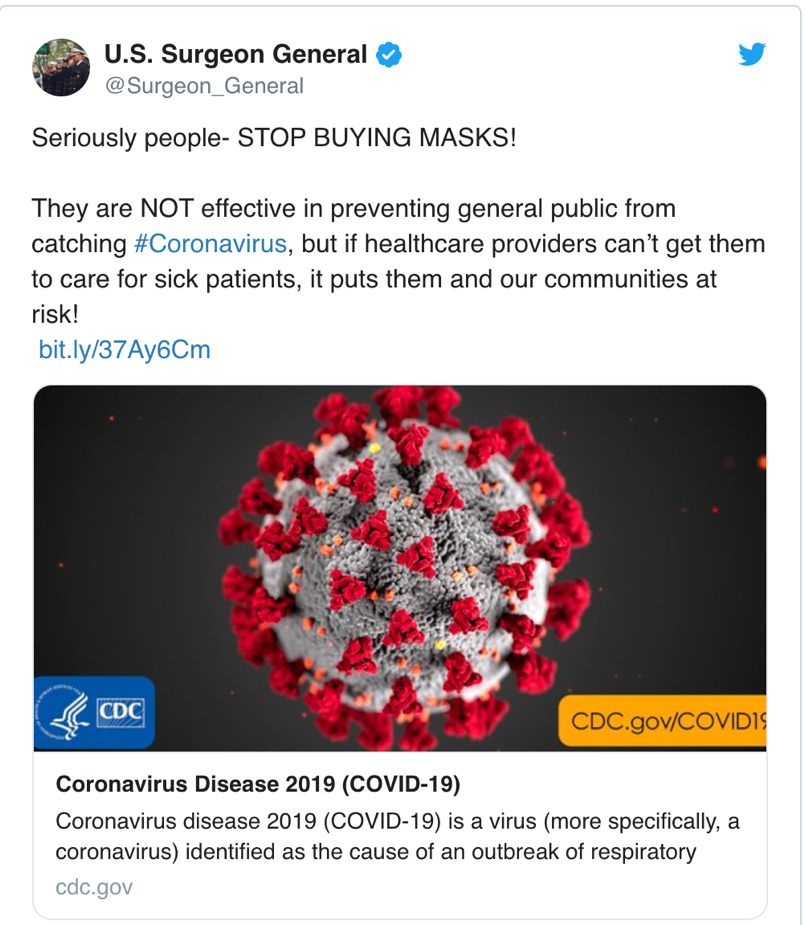
In most cases, if you are in contact with someone who is contagious, even if you have a mask, you have a good chance of becoming infected just like the people without a mask.
I would not wear a mask, but it is a personal decision.
I recently went to see the doctor and I was immediately asked to wear a mask. I did not realize how uncomfortable they are.
They are very hot and I found it challenging to take my attention off the mask. Wearing a mask may be a bit distracting while you are driving. Do as you see fit.
6) Switch To Delivery
Since people are the problem, then stop delivering people.
With many restaurants and bars switching to take out or delivery only, you know delivery apps are going to be busy. You could deliver food for services like Postmates, Uber Eats, or DoorDash.
Additionally, Instacart is booming right now. If you don’t mind shopping for groceries, sign up and start working for Instacart right away. You could also save money on groceries and gas using these cash back apps.
We have a full list of the best gig jobs to sign up for here.
Good reliable drivers are in demand, and many companies offer a decent sign-on bonus. You might be able to make decent money switching things, earn a nice bonus in the process, and dramatically increase the safety of your work environment.
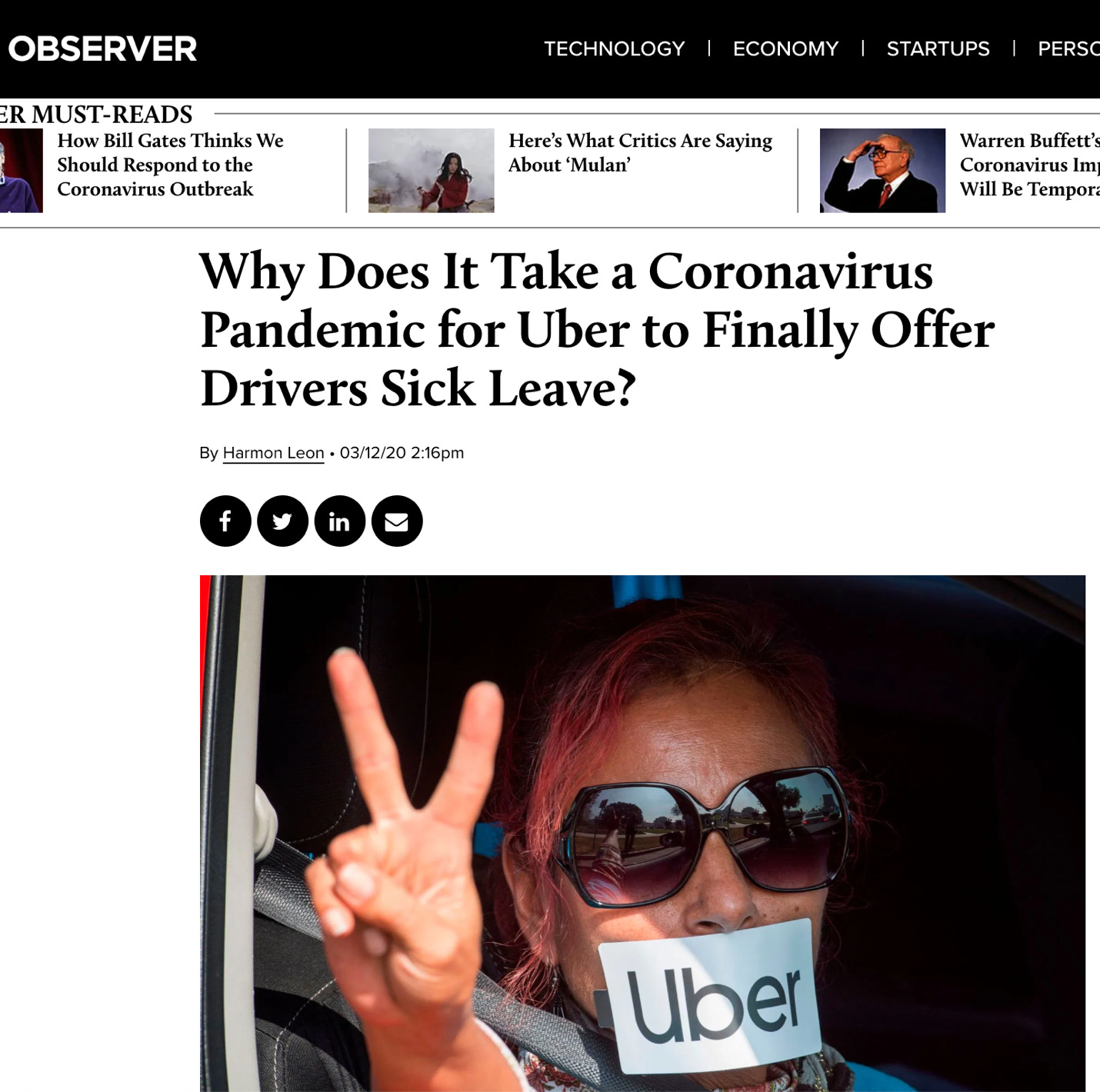
7) Take Advantage Of The Company’s Sick Pay Policy
What happens if you do get sick and you can’t work for two to three weeks? Most of the rideshare companies have announced programs to provide sick pay for drivers who contract the coronavirus.
Andrew MacDonald, Uber’s senior vice president of rides and platform, said this:
“We are supporting drivers and delivery people who are diagnosed with COVID-19 (coronavirus) or placed in quarantine by a public health authority.” We believe this is the right thing to do.”
Lyft spokesperson Alexandra LaManna said this:
“We will provide funds to drivers should they be diagnosed with COVID-19, or put under individual quarantine by a public health agency.”
Clearly, no company wants to have a driver infecting passengers. That would be a public relations nightmare.
Instead, you get sick, stop driving and take what you can get from Uber, Lyft, DoorDash or whatever company you are representing.
You are doing the company a favor by getting off the road. Let them do you a favor by accepting additional compensation.
Key Takeaways for Surviving the Coronavirus As a Rideshare Driver
There is no denying that for many drivers, this is a difficult time. You may not want to drive, but you have to drive to pay the bills, put food on the table, and keep the lights on.
If you do have to drive, protect yourself and take precautions. Maybe you want to switch it up and deliver food or groceries.
You have options – take advantage of them. Be safe out there.
Readers, what precautions are you taking or what changes have you made as a rideshare driver?
-Jay @ RSG
Resources:
- Stay up to date with all the latest rideshare driver coronavirus news here
- Sign up for one of the many (busy!) delivery gig jobs out there
- Instacart is booming right now – read up on Instacart shopper pay here and sign up!
